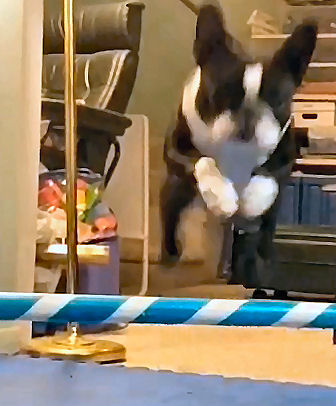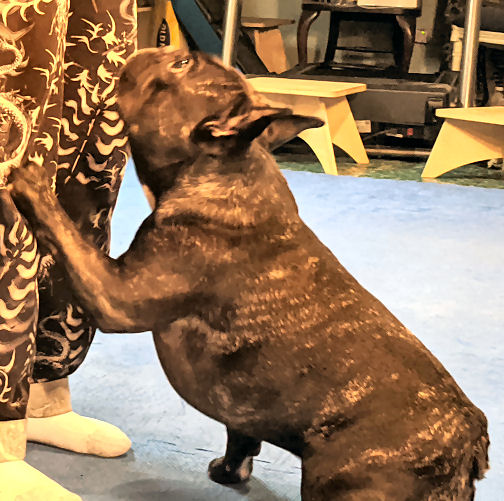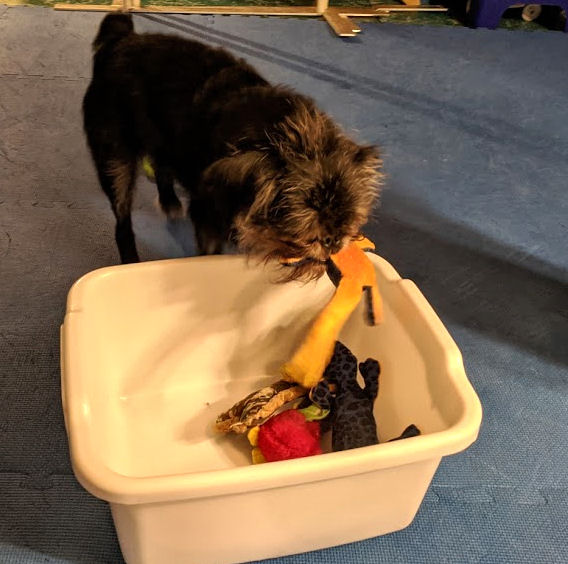It’s extremely rewarding to see the results of your training. It’s sometimes hard to stay positive in dog training and have faith that you’re making a difference. Lately we’ve had a couple of wonderful examples of how patience and positivity work. We’re changing lives, especially our own, with the power of positive reinforcement training.
By Simon, we think he’s got it!
Simon, Fran’s 2-year-old Boston Terrier is a nosey fellow. He has to check out everything that’s going on, and right in the middle is where he wants to be. Like most Bostons, he’s also incredibly friendly and wants to run up to everyone for overly-enthusiastic greetings.

Our yard is surrounded by a four-foot chain-link fence. Our neighbor was out in his yard and Simon felt compelled to run over to say “Hi! Hi! Hi! Hi! Hi!” And repeatedly jump, bouncing off the fence at about 3.5 feet.
The neighbor is a very tolerant man, and accustomed to living next door to dogs, so he ignored Simon entirely. Which gave Hope the opportunity to get close, say Simon’s name, and instantly reward when he turned to look at her. We could see him think about resuming the jumping, greeting craziness, but he didn’t. We could actually see him decide. Paying attention to Hope was more rewarding than greeting the man.
Laying the foundation
Simon’s good choice was something we’ve worked on forever. He’s finally becoming mature enough to make choices. Essentially, Simon is an adolescent with all the decision-making skills of human teenagers. And since he was a puppy, he’s been rewarded for choosing us over anything else.
Our dogs are always rewarded for coming to us. Always. Every single time. Because we always want them to come to us when called. If they’ve been incredibly naughty, we don’t call, and we don’t say their names. We go to them for the ensuing discussion. Our dogs’ names and “Come!” always have to be linked to something good. (See “Get your dog to come dashing to you every time.“)
We always want to stay positive in dog training. There’s good reason for this. We always want our dogs to come running happily to us when called. Especially if there’s a skunk in the yard. Or the handyman left the gate open.
Positive works on people, too!
It occurred to us this week that the “stay positive” message has worked in our retail life, too.
When our current mail carrier first came on the route, he was not communicative, did his job reluctantly, sometimes didn’t bother showing up, and was generally surly and unpleasant.
Over the course of months, that’s changed. He now comes into our shop with a smile on his face, a friendly greeting, and looks out for us. He even went out of his way to learn a new way of using his equipment to help us get our outgoing packages into the postal system computer faster.
Also a dog person
All we did to change things around was stay positive. Regardless of his demeanor, we greeted him with a smile. Thanked him for everything he did. Gave him treats for his dog. Some days it wasn’t easy. Especially when he “forgot” to come back to pick up our outgoing mail, and we had to rearrange our schedules to go to the post office.
Over the course of months, our mail carrier has learned that coming into our shop will always be a pleasant experience. We’re never going to yell at him, never take our bad mood out on him, and always going to be happy to see him – even when he’s bringing monthly bills.
You may get the impression that we’ve “trained” our mail carrier to be the service person we wanted. You would be right. And all through our determination to stay positive.



